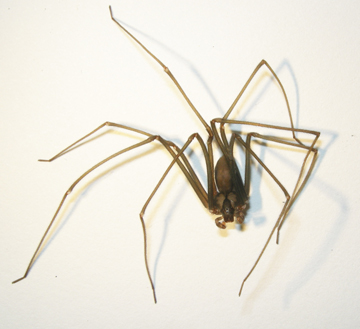Binford Spider Lab
Research interests
The chemical richness and diversity of spider venoms make them interesting subjects for understanding how evolution generates novelty. Our National Science Foundation funded research uses integrative, evolutionary approaches to better understand patterns of diversity in spider venoms. Students participate in evolutionary analyses of spider venoms at all levels of the process. This includes collecting a range of spiders in the field, doing protein analyses of the venoms, and using molecular approaches to study the genes that code for the venom proteins. We also are studying the evolutionary history of the spiders themselves to create a framework we can use to analyze venom evolution. Students also analyze the effects of venoms on insect prey and observe spider foraging behavior. These data help to better understand the role venom plays in immobilizing prey and how that varies across spider species.

Loxosceles from Guinea, West Africa
Our current research is focused on brown recluse and their relatives (Loxosceles). We have discovered that the toxin in venoms of Loxosceles that causes dermonecrotic lesions (sphingomyelinase D, or SMase D) is also present in venoms of some species in the closely related genus Sicarius. This means this toxin likely originated in an ancestor of these two types of spiders. This knowledge helps us better understand the range of species related to the brown recluse that is capable of causing lesions when these animals bite people. Knowing how the toxin varies among species may help to facilitate development of treatments that will work for bites of all members of this group of spiders.
We use molecular phylogenetic methods to reconstruct the evolutionary relationships between species of Loxosceles and Sicarius and use those relationships as a framework for understanding the molecular evolution of SMaseD within their venoms. Based on past research, we know that Sicarius and Loxosceles shared a common ancestor on Western Gondwana, the ancient supercontinent that broke apart to become South America, Africa, Australia, Antarctica, and India. This means that SMase D originated more than 100 million years ago and has had ample time to evolve and diversify. The phylogenetic relationships of these spiders also show that Loxosceles began diversifying before Africa and South America split apart and some African species are more closely related to South American species than to other African species. This means that the SMase D in their venoms is more similar to the SMase D of South American Loxosceles than to that of other African species. This information is directly applicable to developing antivenoms that are effective across a broad geographic range.
In addition to our principal research program, we are also interested in topics such as species delimitation and the influence of geological history on the present-day distribution of Loxosceles and Sicarius. Working with these spiders has inspired tangential biodiscovery research on topics ranging from the functional morphology of the tiny hairs (setae) of Sicarius which they use to adhere sand to their bodies for camouflage (in collaboration with Kellar Autumn) to the isolation and characterization of small neurotoxins from spider venoms (in collaboration with Niko Loening).

Our research is funded by the National Science Foundation.
Spider Resources
Brown Recluses, Hobo Spiders, Daddy Longlegs
The American Arachnological Society
Tree of Life Web Project (Spiders page)